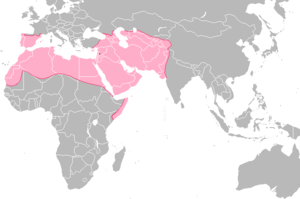Islam in Pakistan

Islam is the official religion of the Islamic Republic of Pakistan. As of 2017, 97% of the population is Muslim, with 75% being Sunni and 20% Shi'a.[1] There are about~230 millions (2021 est.)[2][3]
Muslim population in Pakistan[4] which is the second largest Muslim population in the world after Indonesia. The Shi'a Muslim population is the second largest in the world after Iran, more than 60 million. Pakistan has been called a "global centre for political Islam".[5] Pakistani nationalism is religious in nature being Islamic nationalism. Religion was the basis of Pakistani nationalist narrative.[6]
History[edit]

In 644 A.D. an Arab Army under the command of Hakam defeated the combined forces of Makran and Sindh, which was prominently Buddhist at the time. The period of Arab rule brought the religion of Islam to the Indus Valley. The Baloch tribes gradually embraced Islam, replacing their centuries-old Zoroastrian religion. Islam arrived in the area of modern Pakistan in 711 AD, 79 yrs after the of death of the prophet Muhammad. The Umayyad dynasty sent a Muslim Arab army led by Muhammad bin Qasim al-Thaqafi against the ruler of Sindh, Raja Dahir. Raja Dahir had given refuge to many Zoroastrian Princes who had fled the Islamic conquest of the Persian Empire. Muhammad Bin Qasim's army was defeated in his first three attempts. The Muslim army conquered the northwestern part of Indus Valley from Kashmir to the Arabian Sea.
The arrival of the Arab Muslim armies to the provinces of Sindh and Punjab, along with subsequent Muslim dynasties, set the religious boundaries of South Asia. This would lead to the development of the modern state of Pakistan as well as forming the foundation for Islamic rule across much of South Asia. Following the rule of various Islamic empires, including the Ghaznavid Empire, the Ghorid Kingdom, and the Delhi Sultanate, the Mughals controlled the region from 1526 until 1739. Muslim technocrats, bureaucrats, soldiers, traders, scientists, architects, teachers, theologians and Sufis flocked from the rest of the Muslim world to Sultanate and Mughal Empire in South Asia.
References[edit]
- ↑ [1] Archived 2020-05-24 at the Wayback Machine CIA World Factbook - Pakistan
- ↑ "Headcount finalised sans third-party audit". 26 May 2018.
- ↑ "POPULATION BY RELIGION" (PDF). www.pbs.gov.pk. Archived from the original (PDF) on 2020-03-29. Retrieved 2019-01-15. Unknown parameter
|url-status=ignored (help) - ↑ 2008 World Population Data Sheet
- ↑ Ḥaqqānī, Husain (2005). Pakistan: between mosque and military. Washington: Carnegie Endowment for International Peace. p. 131. ISBN 0-87003-214-3. Retrieved 23 May 2010.
Zia ul-Haq is often identified as the person most responsible for turning Pakistan into a global center for political Islam. ...
Search this book on
- ↑ Ahmed, Ishtiaq (27 May 2016). "The dissenters". The Friday Times. Archived from the original on 26 July 2020. Retrieved 8 August 2022. Unknown parameter
|url-status=ignored (help)
| This religion-related article is a stub. You can help EverybodyWiki by expanding it. |
